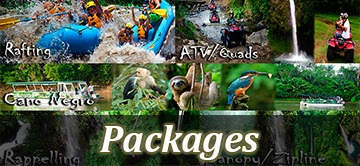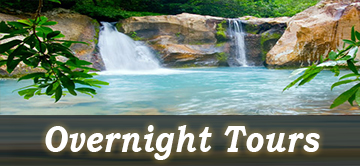Costa Rica is located in the Central American Isthmus, within the geographical coordinates 8° and 11° north latitude and 82° and 85°, of west longitude. Including its insular area it has an extension of 51,100 km (50,660 km ² of land and 440 km ² of water). Next to Belize and El Salvador, Costa Rica is one of the smallest Republics of Central America. It limits the north with Nicaragua, which it shares 309 km of frontier and in the south with Panama which shares 639 km, to the east with the Caribbean Sea and the west with the Pacific Ocean.
The length of the coast includes 1,228 km, of which 1,016 are in the Pacific coast and 212 km in the Caribbean Sea. The Pacific coast presents irregularities like peninsulas, gulfs and bays, conditions that provide the establishment of harbor zones and the tourist development.
Political Map
It is divided in seven provinces:
San José (the capital) (4 959 km2),
Alajuela (9 752km2)
Heredia (2 656 km2)
Cartago (3 124 km2)
Puntarenas (11 276km2)
Limon (9 188 km2)
Guanacaste (10 140 km2)
Coco Island, a National sovereignty in the Pacific Ocean,
the position is: 5°30′ north latitude and 87°06’ west length.
The last population estimation was made in year 2000; it gives a result of 3.824 593 inhabitants and 50% of these lives in the great metropolitan area.
The metropolitan area includes the central part of the country and an altitude average of 1.000 meters on the sea level. Costa Rica, due to its position in a tropical zone of the planet, characterizes by the high temperatures and rains during great part of the year.
In the other part the Caribbean coast is more regular, but less appropriate for this services. The country has sovereignty on 200 mn (nautical mile) of economic exclusive zone, and 12 mn of territorial waters.
From its origins Costa Rica has been a biological bridge where species of flora and fauna come, from the Neo-Arctic, the Neo-tropic and some others of the Antilles regions. Due to this biodiversity, life zones are located from the coastal landscapes to the desert landscapes on the 3.000 m altitude.
The biodiversity allows the country to have one around 360 species (150 amphibians and 210 reptiles), birds of approximately 850 species (625 nest and 225 are migratory), 205 mammals species, between non-flying mammals and bats.
Classic white and black sandy clean beaches involve tourist with the ocean. In the mountainous needle, land comes from the northwest to the southeast. Also a highest peak of the Chirripo Hill impressed everyone culminating at the 3820 meters high.
Costa Rica has two different seasons, the rainy or winter from May to November and the dry or the summer from December to April.
In June and in July light rains may appear but specially at night.
In Costa Rica you can find opposite climates very near. You can reach the hotness beach or the coldest mountain in just two hours.
Mountains chains come from the NW to the SE. There are four important ranges in our country: The Guanacaste, Tilaran, Central and Talamanca.












